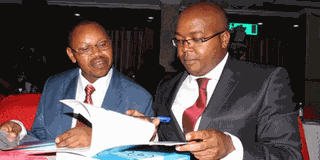Take up of ICT in health sector improves efficiency

Devolution and Planning Principal Secretary Torome Saitoti (left ) with his Health counterpart Nicholas Muraguri in KICC, during the launch of the 2014 Kenya Demographic and Health Survey on January 14, 2016. The Health ministry has reviewed and revised the training curriculum of health records and information management to align it to technological advancements. PHOTO | EVANS HABIL | NATION MEDIA GROUP
What you need to know:
- He said the initiative was in line with the Vision 2030 and the Ministry flagship project to digitize health facilitates, in order to increase access to specialized care through e-referral and telemedicine.
Digitisation of services in the health zone has markedly reduced the wasteful parallel reporting systems making it easier to deliver services to patients, Principal Secretary Nicholas Muraguri observes.
He said Thursday that Local Area Network, a computer network that covers a relatively small area, had been installed in 12 counties servicing 106 health facilities and 11 County Departments of Health - with multi-channel broadband capabilities.
The Data Services Layers (DSL), an ICT infrastructure, is meant to enable better decision-making within the health care system.
“This technology will enable the ministry to have a robust layered data analysis to be able to tackle complex strategic and operational issues better than before. This is the roadmap the ministry wants all stakeholders and partners to take as we endeavour to strengthen the national systems at national and the county levels.”
He said the initiative, supported by Usaid through the AfyaInfo project, was in line with the Vision 2030, Sustainable Development Goals, and the Ministry flagship project to digitize health facilitates, in order to increase access to specialized care through e-referral and telemedicine.
“The Government and the Ministry of Health is in search of good evidence to support decision-making at all levels of health management,” he said during the Usaid-AfyaInfo project- conclusion event on Thursday in Nairobi.
Dr Muraguri said the Ministry had roped in the University of Nairobi in maintenance of the Health Management Information Software System version 2 (DHIS2), a web-based open-source information system that collects, manages, helps in visualization and exploration of data.
“The cost of scaling up the system using domestic resources within our local universities has been significantly lower compared to what we would have utilized on international consultancy,” he said, urging development-oriented partners to help in providing better health services to Kenyans.
Consequently, the Ministry has reviewed and revised the training curriculum of health records and information management to align it to technological advancements.





